"Lake Biwa Rowing Song" Locations 琵琶湖周航の歌の名所
|
Title   • File Name • File Name   • Date • Date   • Position • Position   |
|

About the song and rowing route... この歌について(日本語解説)Shiga Prefecture's most famous and beloved song is called Biwako Shuko no Uta (琵琶湖周航の歌) or "Lake Biwa Rowing Song." I have rendered this song into both pictures and English, according to my own imagination and interpretation.
Please see this page for a full explanation: https://photoguide.jp/txt/Lake_Biwa_Rowing_Song
First composed in 1917 by a bunch of college students from Kyoto, the song has been recorded by many famous Japanese singers and groups. In 1971, it became a major nationwide hit with singer Tokiko Kato's rendition. Today, the song remains a favorite among choir groups in Japan, and a choir singing contest is held for the song every June (since 1997) in Imazu, the birthplace of the song in the northwestern corner of Lake Biwa.
Shiga Prefecture also has stone monuments dedicated to each of the six verses. There's even a museum (Biwako Shuko no Uta Shiryokan) in Imazu dedicated to the song. Okaya city on the shores of Lake Suwa in Nagano Prefecture, the birthplace of the song's composer, Taro Oguchi (小口太郎) (1897-1924), also has a song monument and bronze statue of him.
|
|

The photo above shows part of the stone monument for the first verse of the song. It reads "Ware wa Umi no Ko" (We're children of the lake). [url=http://photoguide.jp/txt/Lake_Biwa_Rowing_Song]More info about Lake Biwa Rowing Song here.[/uThis is the song's first and most famous line. The monument is in a small park near the former boathouse in Mihogasaki pier. The photo has been digitally altered (the colors are not real).
I visited and photographed all the places mentioned in the song as well as all the song monuments in Otsu, Omi-Maiko, Imazu, Chikubushima, Hikone, Chomeiji, and Okaya (Nagano). I also created some digital images to match the scenes mentioned in the song.
|
|

"Umi no Ko" (Child of the Lake) Lake Biwa training boatThe bow of Shiga Prefecture's "floating school." The name of this boat was obviously taken from the song. The boat is owned by Shiga Prefecture and used to educate elementary school kids about the lake. Since 1983, this ship has been serving as a floating school for kids where they stay overnight and spend two days conducting experiments to learn more about the lake. Picture was taken at Hikone Port.
|
|

"Umi no Ko" (Child of the Lake) Lake Biwa training boat for kids
|
|

Mihogasaki harbor, Otsu. The arrow points to the boat house where Oguchi Taro and crew departed for their rowing trips.Mihogasaki is accessible by bus from Otsu Station. Or just walk west from Hama-Otsu. This is also where water from the lake is drawn into the Biwako Canal's first canal which feeds water to Kyoto.
|
|

Mihogasaki harbor, Otsu. The arrow points to the boat house.
|
|

Boat house where Taro Oguchi and crew departed on their rowing trip. No longer used by the university's boat club. Mihogasaki, Otsu
|
|
|

Verse 1 Lyrics (Otsu) 一番の英訳(大津). School logo on boat house, a cherry blossom with three stripes for Dai-san Koto Gakko.We're children of the lake, off to wander 'round.
This journey fills my heart with, intense happiness.
Rising mist evaporates, ripples come and go.
Shiga's Miyako dear, bid farewell for now.
われは湖の子 さすらいの
旅にしあれば しみじみと
のぼる狭霧や さざなみの
志賀の都よ いざさらば
Ware wa Umi no Ko, sasurai no
tabi ni shiareba, shimijimi to
Noboru sagiri ya, sazanami no
Shiga no Miyako yo, iza saraba
--
This first verse refers to the start of the journey of life. The lake mist symbolizes the uncertainty of what lies ahead.
The capital of Shiga is Otsu, where they departed from Mihogasaki boat harbor on June 27, 1917. For some reason, the kanji characters for "Shiga" is incorrect for Shiga Prefecture.
|
|

"Rising mist evaporates, ripples come and go." のぼる狭霧や さざなみの
|
|

Reeds bid rowers farewell for now...
|
|

Rear of boat house, now used by a private boat club.
|
|

Verse 2 Lyrics (Omatsu/Omi-Maiko) 二番の英訳(雄松"Pine trees are very green, on sands very white.
Omatsugasato is, a young maiden's home.
Bush of red camellia, hides her teary face.
She's weeping o'er a lost love, much too short to last.
松は緑に 砂白き
雄松が里の 乙女子は
赤い椿の 森蔭に
はかない恋に 泣くとかや
Matsu wa midori ni, suna shiroki
Omatsugasato no, otomego wa
Akai tsubaki no, morikage ni
Hakanai koi ni, naku toka ya
Omi-Maiko is still famous for white sand beaches and pine trees. In summer these beaches are cluttered with people trying to get a tan.
See more photos of Omi-Maiko here.
|
|

"Pine trees are very green, on sands very white." Omi-Maiko
|
|

White sands of Omi-Maiko (Omatsu), Otsu, Shiga
|
|

Ripples lap white sands of Omi-Maiko.
|
|

Pine trees at Omi-Maiko
|
|

Kyoto University Rowing Club arrive at Omi-Maiko in Aug. 2006 during their annual Lake Biwa rowing trip.
|
|

Omatsu "Famous Place" marker
|
|

Omatsukan ryokan at Omi-Maiko. This is where Oguchi Taro and rowing mates stayed when they rowed around Lake Biwa. 雄松館
|
|

Verse 3 Lyrics (Imazu) 三番の英訳(今津) "We drift from wave to wave..."We drift from wave to wave, straying aimlessly.
On shore we see red fire, brings back memories.
With our sights set nowhere, rolling with the waves.
Today is Imazu or, Nagahama huh.
浪のまにまに 漂えば
赤い泊火 懐かしみ
行方定めぬ 浪枕
今日は今津か 長浜か
Nami no mani mani, tadayoeba
Akai tomaribi, natsukashimi
Yukue sadamenu, nami makura
Kyo wa Imazu ka, Nagahama ka
|
|

"On shore, we see red fire"Imazu was where the song was born. The town has two monuments for the song. One is the lamp monument built in 1985 on the boat pier (top photo) for Verse 3 (written on the lamp post), and the other is a red stone monument in the shape of a fire dedicated to the entire song. The lamp monument lights up in red at night. The above image was digitally altered.
|
|

"On shore we see red fire, brings back memories." (Imazu)This is the lake beach at Imazu.
See more photos of Imazu here.
|
|

Lake shore at Imazu
|
|

Peninsula where Oguchi Taro and crew departed Imazu. On this peninsula at Imazu, Taro Oguchi and crew departed in their boat for Chikubushima island. The large building is a boathouse that stores two reconstructed fixed-seat boats.
|
|

The large boat house houses two reconstructed fixed-seat boats. This is where Oguchi and crew departed Imazu for Chikubushima.
|
|

Lake waters of Imazu, with Chikubushima and Mt. Ibuki in the distance.
|
|

Nagahama Castle as seen from Lake Biwa. More photos of Nagahama here.The castle tower was reconstructed in 1984.
More photos of Nagahama here.
|
|

Imazu shore
|
|

Imazu road along the lake shore, near Chojiya inn.
|
|
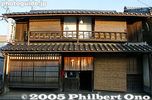
Chojiya ryokan inn, Imazu. This is probably the inn where Taro Oguchi and crew stayed in Imazu and created the song in 1917. 丁子屋It is along the lake shore and still in business today.
It was on June 28, 1917 in Imazu, after dinner on the second day of their rowing trip, when a boatmate named Jiro Nakayasu exclaimed, "Hey everyone, listen up! Oguchi has written this song," and showed everyone the song. Then another boatmate named Taniguchi, who knew a popular song called Hitsuji Kusa (Water Lilies), began singing Oguchi's lyrics to the melody. Since the melody went well with the words, the seven boat crewmates sang the song together that night. It was the birth of the Lake Biwa Rowing Song. The boys worked on the song further and sang it while rowing.
See more photos of Imazu here.
|
|

Chikubushima as seen from Imazu
|
|
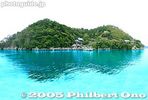
Verse 4 Lyrics (Chikubushima) 四番の英訳(竹生島)Azure blue flower garden, revered coral shrine.
Full of old-time stories, Chikubushima.
In the hands of Buddha, one young maiden lies.
She's sleeping in compassion, resting peacefully.
瑠璃の花園 珊瑚の宮
古い伝えの 竹生島
仏の御手に いだかれて
ねむれ乙女子 やすらけく
Ruri no hanazono, sango no miya
Furui tsutae no, Chikubujima
Hotoke no mite ni, idakarete
Nemure otomego, yasurakeku
Lake Biwa's most famous and sacred island is accessible by boat from Hikone, Nagahama, and Imazu. Color of the water in the photo is not real.
|
|

"Full of old-time stories, Chikubushima."The island has a complex of temples named Hogonji. It belongs to the Shingon Buddhist Sect (Buzan School). It is said that it was first built in 724. It is also the 30th temple in the 33 Temple Pilgrimage of Saigoku (Western Japan).
See more photos of Chikubushima here.
|
|

"Azure blue flower garden, revered coral shrine."
|
|

Broken dishes near the torii
|
|

"Full of old-time stories, Chikubushima." Karamon Gate, National Treasure
|
|

Karamon Gate, National Treasure. Renovated in March 2020.
|
|
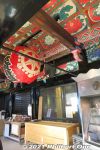
Kannon-do Hall, Hogonji Temple.
|
|

Buddha statue on Chikubushima
|
|
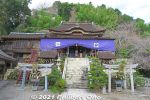
Tsukubusuma Shrine (National Treasure), Chikubushima 都久夫須麻神社
|
|
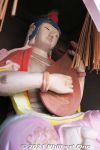
Benzaiten Goddess with her biwa lute.
|
|

Benzaiten-do Hall, Hogonji Temple's Hondo main hall.
|
|
|

Verse 5 Lyrics (Hikone) 五番の英訳(彦根)Sharp arrows buried deeply, way into the ground.
Abundant summer grasses, a moat still remains.
Standing in an old castle, all alone oneself.
Hira and Ibuki too, only but a dream.
矢の根は 深く埋もれて
夏草しげき 堀のあと
古城にひとり 佇めば
比良も伊吹も 夢のごと
Ya no ne wa, fukaku uzumorete
Natsukusa shigeki, hori no ato
Kojo ni hitori, tatazumeba
Hira mo Ibuki mo, yume no goto
--
This is the only verse where the setting is not specifically mentioned. The only hint is "old castle," which must be either Nagahama Castle or Hikone Castle. It is likely that it is Hikone Castle with its authentic castle tower and moats.
See more photos of Hikone here.
|
|

"Abundant summer grasses, a moat still remains"
|
|
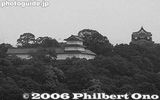
Hikone Castle
|
|
|
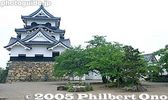
More photos of Hikone Castle here.The castle tower is a National Treasure. Hikone Castle is one of only five castle towers in Japan designated as National Treasures. (The others being Himeji, Inuyama, Matsumoto, and Matsue Castles. Nijo Castle in Kyoto is also a National Treasure, but it does not have a castle tower.)
See more photos of Hikone Castle here.
|
|

Hira mountains
|
|
|
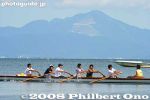
Mt. Ibuki and rowers in Imazu.
|
|

Verse 6 Lyrics (Chomeiji) 六番の英訳(長命寺)Saigoku pilgrimage, Chomeiji.
Dispel this world's impureness, very faraway.
Golden waves on which we weave, rowing all we can.
Tell us my friends your stories, with your fervent hearts.
西国十番 長命寺
汚れの現世 遠く去りて
黄金の波に いざ漕がん
語れ我が友 熱き心
Saigoku Juban, Chomeiji
Kegare no utsushiyo, tooku sarite
Kogane no nami ni, iza kogan
Katare wagatomo, atsuki kokoro
--
This verse is said to refer to the Pure Land of Buddhism. The song has strong Buddhist overtones, but interestingly the melody happens to be based on a Christian hymn. Chomeiji was a lunch stop before they rowed back to Otsu.
See more photos of Chomeiji Temple here.
|
|

"Saigoku pilgrimage, Chomeiji."
|
|

Chomeiji, 31st temple on the Saigoku Pilgrimage Circuit
|
|
|

"Dispel this world's impureness, very faraway."
|
|

Stone monument for Verse 6
|
|

"Golden waves on which we weave..."
|
|

Golden waves
|
|

Regatta on Lake Biwa
|
|
|

"Tell us my friends your stories, with your fervent hearts."
|
|
|
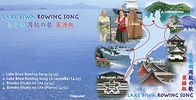
Cover of Lake Biwa Rowing Song CD which went on sale on June 16, 2007. Details here.
|
|
|
|
|
|
|